Warming-fueled droughts and storms imperil populations, industries and even the existence of some countries.
Originally published by Lydia O’Connor at www.huffingtonpost.com
Climate change may be the one thing that threatens everyone on Earth. But the peril is much more dire for people in some countries if negotiators fail to reach a climate deal in Paris in the coming weeks.
The Notre Dame Global Adaptation Index and climate risk consulting group Verisk Maplecroft both release annual rankings of nations most vulnerable to climate change based on geographical conditions and preparedness. Below are some of the countries most threatened by a warming planet.
-
Bangladesh

Probal Rashid via Getty Images
Climate change will inundate Bangladesh — one of the world’s most densely populated countries with some of the least arable land per capita — with “extreme river floods, more intense tropical cyclones, rising sea levels and very high temperatures,” a 2013 World Bank Report warned. Floods, tropical cyclones, storm surges and droughts are already becoming more frequent in coastal areas and in arid and semi-arid regions, the European Union’s Global Climate Change Alliance reports.
“For my country, Bangladesh, the goal of combatting climate change and its impacts is crucial, as we are on the frontline of this global threat,” Bangladeshi Prime Minister Sheikh Hasina wrote on The Huffington Post in September, noting that the nation has experienced 50 percent more rainfall than average this year, causing serious damage to crops. “The pledges on reducing emissions submitted for the Paris climate meeting must be measurable and verifiable.”
In the photo above from 2011, a man affected by floods in Bangladesh’s southwest Satkhira district stands on high land waiting for a rescue boat. -
Chad

Klavs Bo via Getty Images
Verisk Maplecroft’s Climate Change Vulnerability Index and the Notre Dame Global Adaptation Index rank Chad as the No. 1 and No. 2 most climate change-threatened nation, respectively.
As one of the poorest countries in Africa, Chad is not well-equipped to handle catastrophic climate disasters. Extreme weather events in the country may take the form of increasingly severe droughts or devastating floods, the Global Climate Change Alliance reports, and will take a huge toll on Chad’s agriculture, livestock breeding, fisheries, health and housing.
The most striking symbol of climate change in the region is Lake Chad, which has shrunk to nearly one-twentieth of its original size since 1963, according to the U.N.
In the photo above, a boy floats in what was once one of the world’s largest lakes. Other countries bordering Lake Chad - Niger, Nigeria and Cameroon – are alsoseverely affected by climate change and the lake’s shrinking size.
“In all, the experience of countries sharing the Lake Chad further illustrates the mutual challenge we face today and which must be collectively addressed without further delay,“ ”p":{"mnid":“entry_text”,“lnid”:“citation”,mpid’ href=“http://www.pmnewsnigeria.com/2015/11/30/cop21-save-lake-chads-ecosystem-from-depletion-buhari-tells-world-leaders/”>Nigerian President Muhammadu Buhari said Monday in Paris. -
Pacific island nations
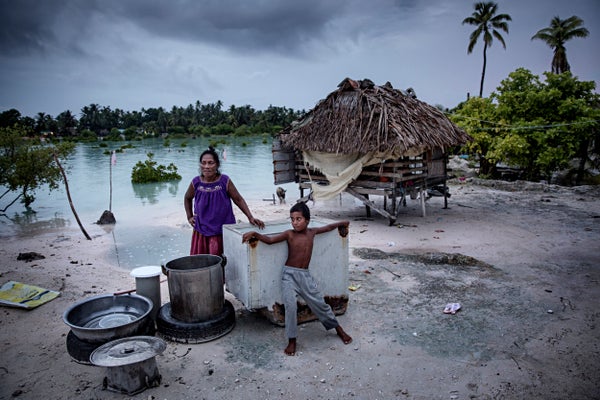
Jonas Gratzer via Getty Images
Low-lying Pacific island nations face the daunting possibility of being completely underwater if climate change isn’t addressed in time.
Kiribati President Anote Tong, whose 33-island nation of 105,000 people has an average elevation of less than 6.5 feet above sea level, said at the Paris summit Monday that Fiji has already offered to shelter its residents in the event that the islands become uninhabitable, Slate reported.
Pictured in the photo above from September, Kiribati villager Beia Tiim said the extreme high tide that used to come every three or four years now comes every three months, and most wells are underwater.
But Fiji is already faces its own climate disaster. At a gathering of Pacific island nations last month, The Guardian reported, Fiji foreign minister Ratu Inoke Kubuabola said the country was seeing a re-emergence of climate-influenced diseases, including typhoid, dengue fever, leptospirosis, and diarrheal illnesses. -
Niger
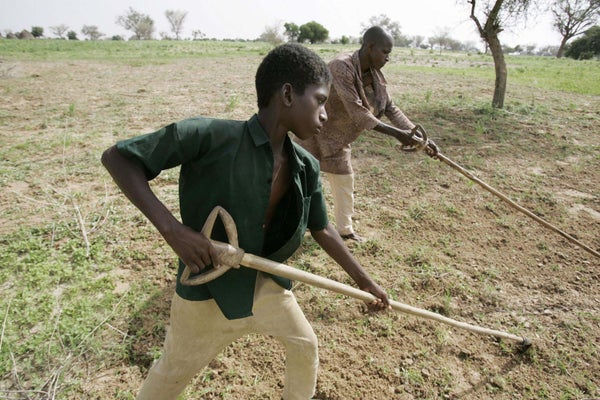
ISSOUF SANOGO via Getty Images
Niger is considered one of the most climate-affected countries because of its high-stakes agriculture sector, which engages more than 80 percent of the population, according to the U.S. Geological Survey.
“Niger is indeed one of the world’s most vulnerable countries because of its”p":{"mnid":“entry_text”,“lnid”:“citation”,mpid’ href=“http://www.worldbank.org/en/news/feature/2013/04/03/tackling-climate-change-in-niger”>exposure to climate risks and its landlocked position," World Bank economist El Hadj Adama Touré explained in 2013. “Compounding this situation are the risks it faces from both internal and regional political extremism. One way or the other, all these factors affect the performance of the agricultural sector and therefore food and nutritional security.”
Resources are stretched in Niger, which has the world’s highest birth rate at 7.6 births per woman, and is predicted to double its population by 2031.
In the photo above from 2005, a Nigerian boy works an agriculture field with his father. -
Haiti

AP Photo/Dieu Nalio Chery
Haiti is a “striking example of ”p":{"mnid":“entry_text”,“lnid”:“citation”,mpid’ href=“http://blogs.ei.columbia.edu/2012/02/01/climate-change-in-haiti/”>how this combination of physical exposure and socioeconomic conditions could lead to extreme climate change vulnerability," Columbia University’s Earth Institute explained.
Haiti’s climate vulnerability is amplified by over-exploitation of its forest, soil and water resources — all of which will be further strained by a changing climate, theGlobal Climate Change Alliance noted.
Haiti lies in a hurricane corridor and is predicted to face more frequent and more severe hurricanes as climate change intensifies, according to Columbia.
In the photo above, a Port-au-Prince resident drains muddy water from a flooded house in 2012 after Hurricane Sandy brought extreme rains. -
Democratic Republic of Congo
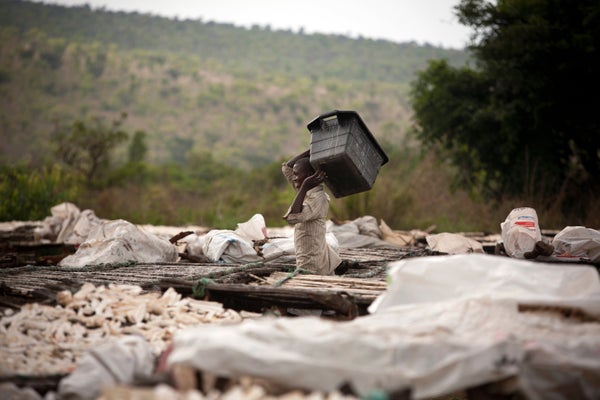
AFP via Getty Images
Climate change is likely to strike agriculture hard and increase the spread of disease in the Democratic Republic of Congo.
In a country where nearly 90 percent of the people rely on agriculture for their livelihood, climate change will likely wreak havoc on crops with more intense rainfall and floods, landslides and soil erosion in the central Congo basin, according to a BBC report. The country can expect the opposite in the south, where the Katanga region will likely see its rainy season shorten by at least two months by 2020.
Malaria and cardiovascular and water-borne diseases also may increase as a result of the warming climate.
In the photo above, a Congolese man helps plant casava between acacia trees that will keep carbon dioxide out of the atmosphere as part of the first "carbon-well" to be registered by the United Nations Framework Convention on Climate Change. -
Afghanistan
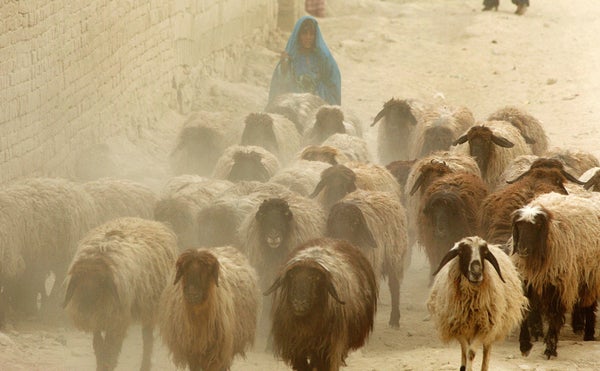
SHAH MARAI via Getty Images
The U.N. identified Afghanistan as one of the countries most at risk of climate change and implemented a $6 million climate change initiative in the mountainous, landlocked, dry country in 2012.
Climate change increases Afghanistan’s likelihood of drought, floods and desertification. The warming climate will likely disrupt agricultural and security developments after three decades of war, warns the Global Climate Change Alliance.
In the photo above, an Afghan girl walks with her sheep down a dusty street in Kabul in 2007. -
Central African Republic
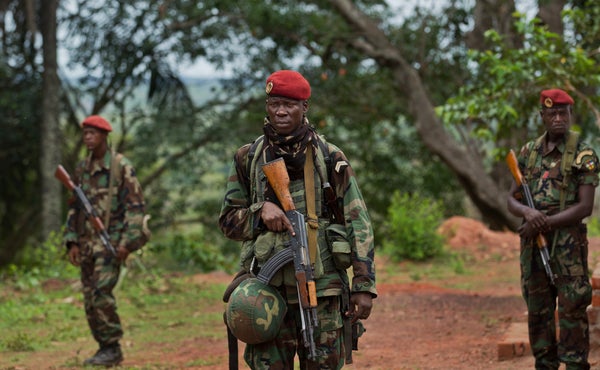
Ben Curtis/AP
The Central African Republic, one of the world’s poorest nations, is experiencing intense civil unrest following the ousting of its leader that will only get worse with climate change.
“By building adaptive capacity, you’re really taking care of some of the development issues, and by bringing people together in a genuinely participatory process, you can really contribute to reducing the conflict and tension within the country,” Denis Sonwa, a scientist and agro-ecologist at Center for International Forestry Research, said.
Agriculture in the country is “still artisanal” without irrigation systems, Sonwa explained, which keeps it dependent on the rainy season.
Meanwhile, recurring floods in Central African Republic capital Bangui cause on average $7 million in damages and losses a year, The Guardian noted.
In the photo above, Central African Republic troops stand guard at a building used for joint meetings between them and U.S. Army special forces, in Obo, Central African Republic. -
Guinea-Bissau
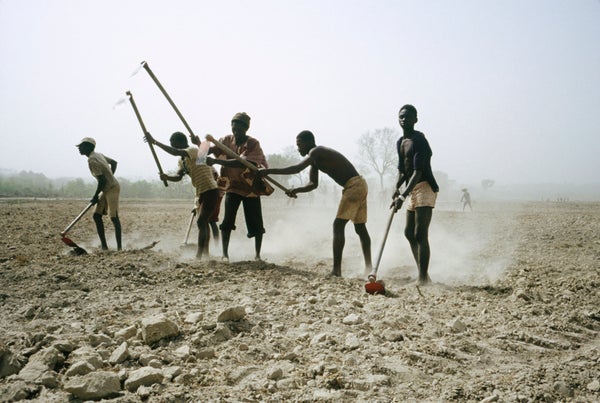
Bengt Geijerstam via Getty Images
Climate change will have severe consequences in Guinea-Bissau, which is largely made up of low, coastal areas and faces intense solar radiation, a government report warned.
The nation’s reliance on rain for its irrigation-free agriculture system is already becoming a problem.
“Rainfall is becoming ”p":{"mnid":“entry_text”,“lnid”:“citation”,mpid’ href=“http://unfccc.int/resource/docs/natc/gnbnc2e.pdf”>increasingly irregular in space and time, a phenomenon accompanied by increase in temperature, thus causing low-yield agriculture, soil degradation by intensification of the phenomenon of evapo-transpiration," the report noted.
In the photo above, farmers plow rice fields outside Contuboel, Guinea-Bissau.